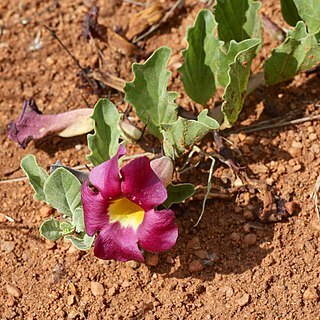Fruit with 4 rows of slightly curved arms bearing recurved spines, the length of longest arm not exceeding the width of the capsule proper, or fruit with 4 rigid wings bearing recurved spines, the wings in the upper portion of the fruit sometimes dissected into short arms; capsule proper 40–50 mm. long and 18–23 mm. broad, the total length of fruit up to 105 mm. and the total width up to 70 mm.
Leaves petiolate; lamina usually 20–40 mm. long, rarely up to 60 mm., and 20–35 mm. broad, very broadly ovate to ovate, pinnatilobed to crenate, often polymorphic; petiole 10–15 mm. long (usually less than half the length of the lamina); limb of corolla purple or yellow, 15–25 mm. in diam.; tube purple, violet, pink or yellow outside, usually more or less yellow inside, 40–50 mm. long.
A herb that lies along the ground. It has a succulent taproot. It produces annual stems. The leaves are opposite. They are broadly oval. The edges have rounded teeth or deep lobes. The flowers are pink with a yellow throat. They occur singly in the axils of leaves. The fruit is a capsule with 4 lines of backward curving spines. There are some subspecies.
Perennial herb with several prostrate annual stems from a succulent taproot, which often forms a thick tuber.
Seeds 10–15 in each loculus, in two rows.

